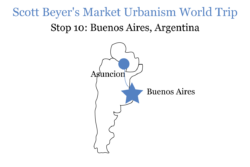The Dangers of Currency Devaluation
How Argentina wrecked its economy, and how it can come back.
Walk through downtown Buenos Aires, and a certain behavior dominates the streets. Currency exchange store employees stand outside and yell that they’re seeking U.S. dollars, euros, yuans—anything to get rid of their Argentine pesos. Ask them, and they’ll banter about the worthlessness of the paper and what it says of the nation’s economic system.
“Nothing works in Argentina,” explained one hawker.
This desire to expunge their pesos is understandable, because Argentina suffers from hyperinflation. In March, their annual inflation rate exceeded 100%, highest in 30 years. To adapt, store owners constantly raise prices. Some spend their pesos as soon as they get them for fear that their money will soon be worthless. Wealthier Argentinians avoid their currency altogether, and trade in US dollars instead.

Some of the causes of inflation here are the same as the rest of the world: COVID-19, supply chain problems, and the war in Ukraine.
But economists say it’s especially bad in Argentina because the government spends so much—far more than they take in—on free health care, college, energy, and transportation. To fund these services, they print more pesos.
It’s not a new problem. Argentina has tried to juice its economy in the past through currency devaluation. In 2001, there was a run on the banks. The government stopped withdrawals and suddenly reduced everyone’s savings. That caused social unrest.
They are at risk of doing it again. The central bank sells dollars to buy pesos no one wants, to try and prop their currency. That’s costing them $60 million per day. They could run out of money and be forced to devalue it again.
This economic malpractice has increased poverty to 37%, up from 30% in 2016. The country has had negative GDP growth 23 of the last 40 years, including during COVID. It’s evident in the look of Buenos Aires, which is a beautiful city but has many of the stagnation symbols one associates with the U.S. urban Midwest.
It’s hard to believe that Buenos Aires was once one of the richest places on earth. According to a study by Maddison Historical Statistics, in 1895-1896, Argentina had the world’s highest GDP per capita.
In the early 20th century, Argentina became rich from exports of livestock and grain. The population grew rapidly. Immigrants from Europe, especially Spain and Italy, flocked to Buenos Aires for job opportunities, peace, and religious freedom.
The city also underwent modernization. Wealthy people built big mansions, which today are used as government buildings and foreign embassies. The city built a subway system. They changed their street design to resemble Paris, building broad avenues along a coordinated block layout. In 1930, they built what they claimed to be the broadest avenue in the world.
Argentina was hit hard by the Great Depression. Slums, or “villas miserias,” sprung up around Buenos Aires. Immigration from Europe stopped. Argentina’s democratically-elected government fell to a military coup.
The coup was a turning point that led to decades of stagnation. The new, populist government was hostile to free markets. The average tariff rate increased from 16% to 28%. They created regulations for resource-intensive products like meat and cereals. The government manipulated the currency in order to protect local industrialists.
Military rule in Argentina ended in 1983, but Argentina still suffers economically. The currency crisis, while particularly bad now, is a terminal problem here. The inflation rate was massive in the early 1990s, has been consistently above 10% since 2006, and recently has again veered into hyperinflation.
Despite this, the country is still one of the richest in South America. But there are things it can do to avoid going down the path of Venezuela or Zimbabwe. It needs to stop printing money to fund social services and deregulate core industries, letting people get jobs in the private sector to support themselves. It needs to ignore populism, embrace free trade, and follow stable monetary policy (or better yet, embrace decentralized finance like El Salvador is doing).
One final note: my stop after Buenos Aires was Montevideo. When bringing my lump of Argentine pesos to local exchange stores, I couldn’t find clerks who would offer nearly any Uruguayan pesos for it. The market at street level, having recognized Argentina’s disastrous policies, was too wise to honor the official exchange rate.
All images credited to Scott Beyer and The Market Urbanist.
Catalyst articles by Scott Beyer | Full Biography and Publications
